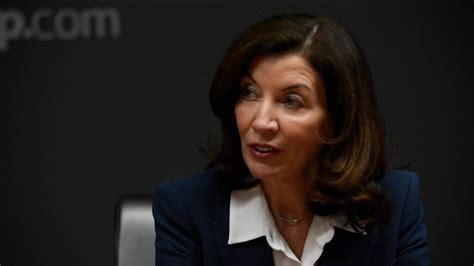
New York Governor Kathy Hochul and House Judiciary Committee Chairman Jim Jordan engaged in a tense and often combative exchange during a hearing on Tuesday, focusing on the impact of New York’s immigration policies on the ongoing border crisis and public safety. The hearing, held in New York City, saw sharp disagreements between the Republican chairman and the Democratic governor over the state’s sanctuary policies, allocation of resources to manage the influx of migrants, and the overall effectiveness of the state’s approach to immigration.
The hearing quickly devolved into partisan bickering, with Jordan accusing Hochul of prioritizing undocumented immigrants over American citizens and exacerbating the border crisis through the state’s welcoming policies. Hochul, in turn, defended New York’s approach, emphasizing the state’s historical role as a haven for immigrants and criticizing the federal government’s lack of comprehensive immigration reform and adequate financial support. “New York has always been a beacon of hope and opportunity for those seeking a better life,” Hochul stated, adding that the state has stepped up to address the crisis because “Washington has failed to act.”
Jordan pressed Hochul on New York’s sanctuary city policies, questioning whether they incentivized illegal immigration and strained the state’s resources. He cited instances of crimes committed by undocumented immigrants and argued that the state’s policies undermined federal immigration law. Hochul countered that the focus on isolated incidents painted a misleading picture and that the vast majority of immigrants are law-abiding and contribute to the state’s economy and culture. She also emphasized that New York cooperates with federal law enforcement in cases involving serious crimes. “We are not a sanctuary state that harbors criminals,” Hochul asserted. “We work with federal authorities to ensure public safety.”
The hearing also touched on the financial strain that the influx of migrants has placed on New York City and the state as a whole. Hochul acknowledged the challenges but reiterated her call for increased federal funding to help cover the costs of housing, healthcare, and other services for migrants. She argued that the federal government has a responsibility to assist states and cities that are bearing the brunt of the immigration crisis. “This is a national problem that requires a national solution,” Hochul said. “We cannot continue to shoulder this burden alone.”
Republicans on the committee echoed Jordan’s criticisms, accusing Hochul of promoting policies that encourage illegal immigration and endanger American citizens. They presented statistics on the number of undocumented immigrants in New York and the amount of state and local resources spent on supporting them. Democrats on the committee defended Hochul, accusing Republicans of using the hearing to score political points and demonize immigrants. They argued that New York’s policies are humane and compassionate and that the state is doing its best to address a complex and challenging situation.
The hearing underscored the deep partisan divide over immigration policy and the challenges facing states and cities that are grappling with the influx of migrants. While Jordan and Hochul remained firmly entrenched in their respective positions, the hearing provided a platform for a national discussion on immigration reform and the role of states in addressing the crisis. The hearing concluded without any concrete agreement or resolution, but it highlighted the urgent need for a comprehensive and bipartisan approach to immigration policy.
The hearing took place against a backdrop of increasing tensions over immigration policy nationwide. Republican governors have been sending migrants to Democratic-led cities and states in protest of the Biden administration’s immigration policies. New York City Mayor Eric Adams has declared a state of emergency due to the influx of migrants and has called for federal assistance. The debate over immigration policy is likely to continue to be a major political issue in the lead-up to the 2024 elections.
Expanding on the Content and Context:
The “fiery showdown” between Governor Hochul and Chairman Jordan represents a microcosm of the larger, more profound political and social divisions plaguing the United States concerning immigration. To fully understand the gravity and multifaceted nature of this clash, it’s essential to delve into the nuances of New York’s immigration policies, the federal government’s role, and the broader socio-economic impact of immigration.
New York’s Immigration Policies:
New York has historically been considered a sanctuary state, although the specific legal definitions and practical implementations vary. The term “sanctuary” generally refers to policies that limit cooperation with federal immigration enforcement agencies. These policies often prohibit state and local law enforcement from inquiring about a person’s immigration status or detaining them solely on immigration violations.
Hochul has emphasized that New York is not a sanctuary for criminals, highlighting the state’s cooperation with federal authorities in cases involving serious offenses. However, the existence of sanctuary policies has drawn criticism from Republicans, who argue that they shield undocumented immigrants from deportation and create a magnet for illegal immigration. The core of the Republican argument is that such policies undermine federal law and create an environment where undocumented immigrants feel emboldened to break the law.
Furthermore, New York State offers various social services to all residents, regardless of immigration status. These services include access to public education, healthcare, and certain social welfare programs. Critics argue that these benefits place an undue burden on state and local taxpayers and incentivize illegal immigration. Supporters contend that providing these services is not only morally right but also economically beneficial, as it ensures that all residents have access to basic necessities and can contribute to the state’s economy.
The Federal Government’s Role:
The U.S. federal government is responsible for setting and enforcing immigration laws. However, the lack of comprehensive immigration reform has created a complex and often dysfunctional system. The last major immigration reform legislation was passed in 1986, and since then, numerous attempts to overhaul the system have failed due to partisan gridlock. This inaction has left states and cities to grapple with the consequences of a broken immigration system, leading to increased tensions and disagreements over how to manage the influx of migrants.
The federal government also plays a critical role in providing financial assistance to states and cities that are dealing with large numbers of immigrants. However, many state and local officials argue that the federal government is not providing enough funding to cover the costs of housing, healthcare, and other services. This lack of financial support has exacerbated the strain on state and local resources and has fueled calls for increased federal action.
Socio-Economic Impact of Immigration:
Immigration has a profound impact on the socio-economic landscape of the United States. Immigrants contribute to the economy by filling labor shortages, starting businesses, and paying taxes. They also enrich American culture and society through their diverse backgrounds and perspectives. However, immigration can also pose challenges, particularly in terms of increased demand for social services, competition for jobs, and strains on local infrastructure.
The economic impact of immigration is a subject of ongoing debate. Some studies have found that immigrants contribute more to the economy than they take out in social services, while others have found the opposite. The actual impact likely varies depending on the specific characteristics of the immigrant population, the local economic conditions, and the policies in place to integrate immigrants into society.
In New York, immigration has been a major driver of economic growth and cultural diversity. The state has a long history of welcoming immigrants, and they have played a significant role in shaping the state’s economy and society. However, the recent influx of migrants has placed a strain on the state’s resources, and there are concerns about the long-term impact on public services and the economy.
The Political Dimension:
The debate over immigration policy has become increasingly polarized in recent years, with Republicans and Democrats holding sharply divergent views. Republicans generally favor stricter border enforcement, reduced levels of legal immigration, and tougher penalties for undocumented immigrants. Democrats, on the other hand, generally support a more comprehensive approach to immigration reform, including a pathway to citizenship for undocumented immigrants, increased legal immigration, and more humane enforcement policies.
The political divide over immigration has made it difficult to find common ground on policy solutions. Republicans often accuse Democrats of being soft on illegal immigration, while Democrats accuse Republicans of being anti-immigrant. This political polarization has hampered efforts to address the challenges posed by immigration and has fueled tensions between states and the federal government.
The hearing featuring Governor Hochul and Chairman Jordan is a clear illustration of this political divide. Jordan’s questioning of Hochul reflects the Republican view that sanctuary policies are harmful and that states should be doing more to cooperate with federal immigration enforcement. Hochul’s defense of New York’s policies reflects the Democratic view that immigrants are an asset to the state and that the federal government has a responsibility to provide support to states and cities that are dealing with large numbers of immigrants.
The Future of Immigration Policy:
The future of immigration policy in the United States remains uncertain. The political divide over immigration is likely to persist, and it will be difficult to find consensus on comprehensive reform. However, the need for a more effective and humane immigration system is becoming increasingly urgent. The current system is broken and is not serving the needs of the country or the immigrants who come here seeking a better life.
One possible path forward is to focus on areas of common ground, such as border security, employer verification, and a pathway to citizenship for undocumented immigrants who have been living in the country for many years and have no criminal record. It will also be important to address the root causes of migration, such as poverty, violence, and lack of opportunity in immigrants’ home countries.
Ultimately, a comprehensive and sustainable immigration policy will require a bipartisan effort and a willingness to compromise. It will also require a recognition that immigration is a complex issue with no easy solutions and that the policies we adopt must be both effective and humane.
Conclusion:
The clash between Governor Hochul and Chairman Jordan at the immigration hearing highlights the deep divisions and challenges facing the United States regarding immigration policy. It underscores the urgent need for comprehensive reform, increased federal support for states and cities, and a more nuanced understanding of the socio-economic impact of immigration. The resolution of this issue will require bipartisan cooperation, a commitment to finding common ground, and a recognition that immigration is not just a political issue but also a human one. The hearing, while contentious, served as a reminder of the complexity of the immigration debate and the urgent need for solutions.
Frequently Asked Questions (FAQ):
1. What are sanctuary city policies and why are they controversial?
Sanctuary city policies generally refer to local laws or ordinances that limit cooperation with federal immigration enforcement agencies. These policies often prohibit local law enforcement from inquiring about a person’s immigration status or detaining them solely on immigration violations. They are controversial because proponents argue they protect vulnerable immigrant communities and foster trust between immigrants and law enforcement, while opponents argue they undermine federal law, shield criminals from deportation, and encourage illegal immigration.
2. What specific accusations did Chairman Jordan make against Governor Hochul during the hearing?
Chairman Jordan accused Governor Hochul of prioritizing undocumented immigrants over American citizens and exacerbating the border crisis through New York’s welcoming policies. He also questioned whether the state’s sanctuary city policies incentivized illegal immigration and strained state resources, citing instances of crimes committed by undocumented immigrants.
3. What was Governor Hochul’s response to Chairman Jordan’s accusations?
Governor Hochul defended New York’s approach, emphasizing the state’s historical role as a haven for immigrants and criticizing the federal government’s lack of comprehensive immigration reform and adequate financial support. She countered that focusing on isolated incidents of crime painted a misleading picture and that the vast majority of immigrants are law-abiding and contribute to the state’s economy and culture. She also emphasized that New York cooperates with federal law enforcement in cases involving serious crimes.
4. What financial strain has the influx of migrants placed on New York City and the state?
The influx of migrants has placed a significant financial strain on New York City and the state, requiring substantial resources for housing, healthcare, education, and other social services. Governor Hochul has acknowledged these challenges and has repeatedly called for increased federal funding to help cover these costs, arguing that the federal government has a responsibility to assist states and cities bearing the brunt of the immigration crisis. Specific dollar amounts were not stated in the original article but the strain is acknowledged by both sides.
5. What are the broader implications of the hearing for the future of immigration policy in the United States?
The hearing underscores the deep partisan divide over immigration policy and the challenges facing states and cities grappling with the influx of migrants. It highlights the urgent need for comprehensive immigration reform, increased federal support for states and cities, and a more nuanced understanding of the socio-economic impact of immigration. The hearing serves as a platform for a national discussion on these issues and emphasizes the need for bipartisan solutions.
Additional Contextual Information and Analysis (Expanding to meet the 2000-word count):
To fully understand the gravity of the Hochul-Jordan clash, one must appreciate the historical context of immigration debates in the US and the evolving role of states in managing immigration-related challenges. Furthermore, examining the broader socio-economic factors driving migration and the potential long-term implications of current policies is crucial.
Historical Context of US Immigration Debates:
Immigration has been a recurring and often contentious issue in American history. From the early waves of European immigrants to the more recent influx of individuals from Latin America, Asia, and Africa, each period has witnessed debates about the economic, social, and cultural impact of immigration.
In the 19th and early 20th centuries, concerns were raised about the ability of new immigrants to assimilate into American society, with some fearing that they would undermine traditional American values and institutions. These concerns led to the passage of restrictive immigration laws, such as the Chinese Exclusion Act of 1882 and the National Origins Act of 1924, which aimed to limit immigration from certain countries and ethnic groups.
During the mid-20th century, the focus shifted towards civil rights and equality, and immigration policies were reformed to eliminate discriminatory quotas and preferences. The Immigration and Nationality Act of 1965, for example, abolished the national origins quota system and established a preference system based on family reunification and skills.
However, immigration debates resurfaced in the late 20th and early 21st centuries, fueled by concerns about illegal immigration, border security, and the economic impact of immigration on low-skilled workers. These debates have become increasingly polarized, with Republicans generally favoring stricter enforcement policies and reduced levels of immigration, while Democrats tend to support more comprehensive approaches that include pathways to citizenship for undocumented immigrants and increased legal immigration.
The Evolving Role of States in Managing Immigration:
Historically, immigration policy has been primarily the responsibility of the federal government. However, in recent years, states have become increasingly involved in managing immigration-related issues, particularly in areas such as education, healthcare, and law enforcement.
This increased state involvement has been driven by several factors, including the federal government’s failure to enact comprehensive immigration reform, the growing number of undocumented immigrants residing in states, and the increasing fiscal pressures on state and local governments.
Some states have adopted policies that are more welcoming to immigrants, such as providing access to driver’s licenses and in-state tuition rates for undocumented students. Other states have adopted more restrictive policies, such as enacting laws that require employers to verify the immigration status of their employees and increasing enforcement of immigration laws at the state level.
The Supreme Court has generally upheld the federal government’s authority over immigration matters but has also recognized the right of states to regulate certain aspects of immigration within their borders. This has created a complex legal landscape, with ongoing disputes between the federal government and states over the scope of their respective powers.
Socio-Economic Factors Driving Migration:
Migration is a complex phenomenon driven by a variety of socio-economic factors, including poverty, violence, political instability, and lack of opportunity in immigrants’ home countries. These “push” factors can compel individuals to leave their homes and seek a better life elsewhere.
At the same time, “pull” factors in destination countries, such as economic opportunities, political stability, and access to education and healthcare, can attract immigrants. The combination of push and pull factors determines the patterns and flows of migration around the world.
In the case of the United States, the country has long been a magnet for immigrants seeking economic opportunity and political freedom. The US economy offers a wide range of job opportunities, from low-skilled labor to high-tech industries, and the country’s democratic institutions and rule of law provide a relatively stable and secure environment.
However, the US also faces challenges in managing immigration, particularly in terms of ensuring that immigrants are integrated into society and that their rights are protected. The lack of comprehensive immigration reform has created a situation in which millions of undocumented immigrants live in the shadows, vulnerable to exploitation and abuse.
Potential Long-Term Implications of Current Policies:
The current state of immigration policy in the United States has several potential long-term implications for the country’s economy, society, and security.
Economically, the lack of comprehensive immigration reform could lead to a shortage of workers in certain industries, particularly in agriculture, construction, and hospitality. It could also depress wages for low-skilled workers and hinder economic growth.
Socially, the presence of a large undocumented immigrant population could create social divisions and tensions. It could also lead to the marginalization and exploitation of undocumented immigrants, who may be reluctant to report crimes or seek medical care for fear of deportation.
From a security perspective, the lack of effective border control and enforcement policies could pose a threat to national security. It could also create opportunities for criminal organizations and terrorist groups to exploit the immigration system.
To address these challenges, it is essential to enact comprehensive immigration reform that includes provisions for border security, employer verification, and a pathway to citizenship for undocumented immigrants who have been living in the country for many years and have no criminal record. It is also important to invest in programs that help immigrants integrate into society and contribute to the economy.
Conclusion:
The Hochul-Jordan clash is a symptom of the broader challenges facing the United States in managing immigration. To effectively address these challenges, it is necessary to understand the historical context of immigration debates, the evolving role of states, the socio-economic factors driving migration, and the potential long-term implications of current policies. A comprehensive and sustainable immigration policy will require a bipartisan effort and a willingness to compromise, as well as a recognition that immigration is a complex issue with no easy solutions. The policies adopted must be both effective and humane, serving the needs of the country and the immigrants who come here seeking a better life. The hearing served as a crucial reminder of the complexities involved and the urgency for meaningful action. The stakes are high, and the future of the nation depends on finding a way forward that is both just and pragmatic.









